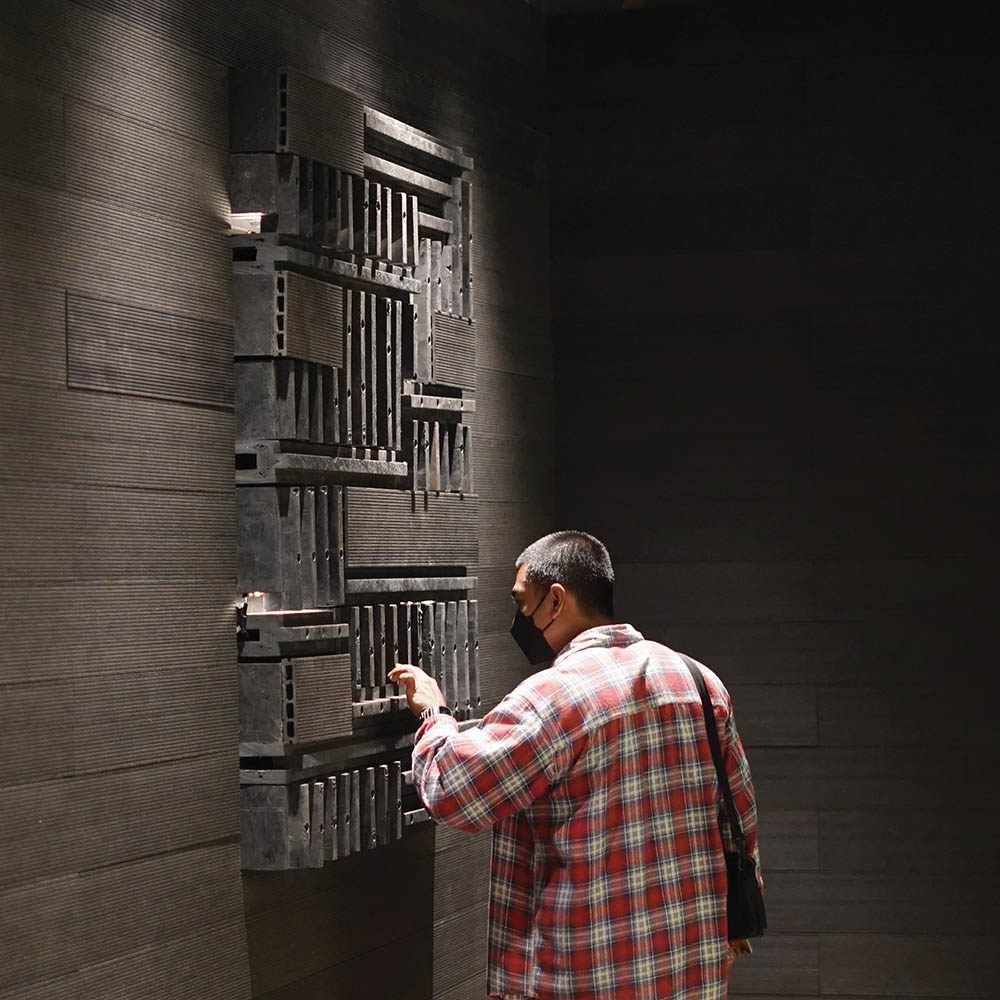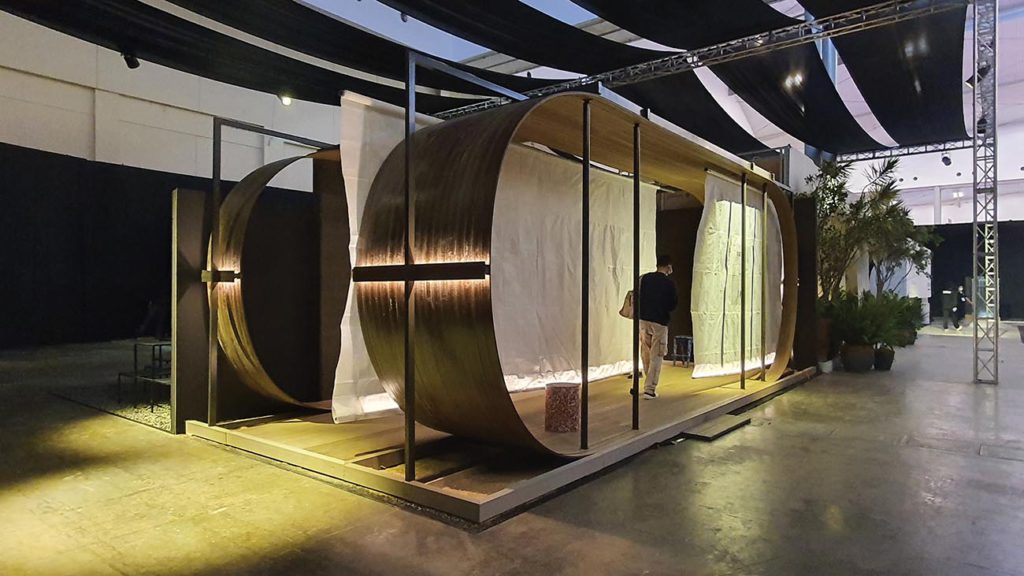2nd Quarter 2022
The potential of circular materials for architectural use in Indonesia
June 15, 2022
Noto Wastu pavilion by Monokroma Architects at NAIFest IndoBuildTech Expo 2022. Photos courtesy of Monokroma Architects; Plana; Mortier

LDPE plastic bags were pressed and stitched together to create partitions
Indonesia, the world’s fourth most populous nation, is currently only able to manage a total of half of its waste. According to 2020 data, 34.6 per cent of waste is managed by dumping in landfills or incinerated, while a mere 14.58 per cent is being reduced, reused or recycled (3R). This puts Indonesia far behind other similarly populated nations, such as China where the recycling rate is around 30 per cent.
The Indonesian Ministry of Environment and Forestry has set 3R targets for at least 30 per cent of all waste and manage the remaining 70 per cent by 2025. In the field of Architecture, Engineering and Construction (AEC), the 3R of waste has been instructed since 2015 through a Ministerial Regulation Number 2 of 2015 on Green Buildings.
While it is already the norm for Indonesia’s construction projects is to reduce materials and reuse (or resell) leftovers for the sake of efficiency, the third ‘R’ in circularity—recycling—remains to be widely implemented.
Achieving circularity means that the entire supply chain of the construction industry needs to push for waste handling and waste-based products, something that is mostly still conducted on a small scale by new companies.
NO WASTE TO WASTE
Designers can play an important role by specifying recycled materials and introducing them to the general public. This was showcased by Tangerang-based firm Monokroma Architects in their pavilion called Noto Wastu: No Waste to Waste, which was created as part of the National Architecture Installation Festival (NAIFest) held at IndoBuildTech Expo 2022 from 22–27 March 2022.
The 32-square-metre installation consisted of a curved rectangular ‘shell’ made out of a wooden-like material, with semi-translucent partitions that divided the space into an exhibition sequence. The shape was meant to symbolise circularity, but it is not merely a visual statement: almost everything was made from waste-based products that are developed by like-minded start-ups.
“In Javanese, noto means ‘arranging’ and wastu means ‘wealth’,” explained the architects about the wordplay behind the title. It is a call for people to rethink waste as something we can make use of—as wealth that we already own.

5-metre panels made out of recycled plastic waste and agricultural by-products
A mycelium-based leather alternative material was used for the partition
Bad plastic, good plastic
There is a common perception that plastic is bad for the environment, while in fact, the material was originally invented to replace paper and protect trees from deforestation. However, it was the economies of scale behind cheaply manufacturing single-use plastics, the carelessness with which people dispose of them, and the lack of proper recycling facilities in many places that compounded the problem of plastic as a pollutant.
When plastic materials can be recycled properly, they lend a durability and flexibility to materials that are well-suited for construction use. As an example, the curved frame of Noto Wastu that resembled wood was actually made from long sheets of husk-recycled plastic composite (HrPC)—made by the start-up Plastic for Nature (Plana) that combined agricultural by-products with plastic waste.
Samples of the raw materials used to create the composite was displayed across a cantilevered HrPC table to inform visitors about its origin as well as demonstrating its versatile application. It was estimated that the use of Plana’s alternative ‘wood’ meant saving as much as 366 trees from being used to decking out the modest-sized space.
Plana also created a wall art in this installation from salvaged black-coloured plastic, elevating what is considered to be the lowest grade of plastic bags as it has been recycled multiple times.
Another startup, Mortier, pressed flat and stitched together 12.4 kilogrammes of low-density polyethylene (LDPE) plastic bags to be used as partitions. The waste from this type of food-grade plastic has boomed with the explosion of app-driven, on-demand food delivery in Indonesia, and so the translucent curtain was devised as an artistic example of its reuse potential.

Cascara and alternative leather used on chair 
Wall art from recycled plastic 
Installation with video and poster
Bio-materials: bacteria as ‘construction workers’
Among the novel materials for construction, mycelium-based ones are considered most sustainable in terms of carbon footprint. Mycelia are the main body tissue of fungi, short of the umbrella-like part—they consist of a thread-like substance which can be ‘fed’ using various organic-based substrates to modify their properties, such as stiffness or density.
They are bio-degradable, cruelty-free, takes up a minuscule fraction of time to harvest when compared to other bio-materials such as timber, and naturally has desirable properties such as being non-toxic, flame-retardant and even anti-radiation.
One of the mycelium-based materials that has been produced in Indonesia is Misel-tex, a leather alternative developed by Bell Society out of cascara (the unused skin of coffee beans).
In a bio-reactor, bacteria perform a ‘weaving’ process to create sheets of mycelium: they eat sugars from the cascara and create strings of cellulose micro-fibres, which eventually aggregate into mycelium sheets that can be further treated to become textile-like materials. This mycelium-based textile was displayed in the installation as the final partition and was also used for furniture upholstery.
FUTURE PROSPECTS
True to the installation’s title, Monokroma Architects followed the ‘no waste’ challenge till the end of the exhibition, when the installation was carefully taken apart. After hours of dismantling, the waste-based materials were sent back to the factories to be reused or recycled. The LDPE partitions were repurposed as curtains, and Misel-tex is currently being experimented upon by the architects’ research and development division for other applications.
[This is an excerpt. Subscribe to the digital edition or hardcopy to read the complete article.]
Read more stories from FuturArc 2Q 2022: New & Re-Emerging Architecture!

To read the complete article, get your hardcopy at our online shop/newsstands/major bookstores; subscribe to FuturArc or download the FuturArc App to read the issues!
Previously Published Happening
Contact us at https://www.futurarc.com/contact-us for older articles.


